View in other NatureServe Network Field Guides
NatureServe
Montana
Utah
Wyoming
Idaho
Wisconsin
British Columbia
South Carolina
Yukon
California
New York
Alpine Grasshopper - Melanoplus alpinus
General Description
The following is taken from Vickery and Kevan (1985) and Pfadt (2002). A small to medium grasshopper. Its general color is gray or light shades of tan, with prominent black markings. Sides of the abdomen are cream colored. The dorsal area of the hind femur is dark with chevron-like markings. The hind tibia can be green, blue or pink.
Phenology
The eggs require a long development period. A study in the Big Horn mountains of Montana showed most eggs required up to 3 years to hatch. No eggs hatched in one year. Alpine Grasshoppers, both male and female, have 5 nymphal instar periods which last 25 to 40 days. The hatching period is short, only 6 to 17 days. They start appearing from early to late June depending upon temperatures, which affect snow melt, soil thawing, and warming. Adults generally appear around mid-July. Numbers tend to dwindle throughout the summer with some individuals surviving into mid-September. Survivors continue to mate and are believed to lay eggs. If weather conditions become inclement they are forced to seek shelter. Early frosts do not seem to affect their survival (Pfadt 2002).
Diagnostic Characteristics
Body is small, ranging from 17-25 mm. Wings (tegmina) long, extending beyond the knee (apices) of the hind femur. The male genital cercus is medium to large, possess a dorsal thumb-like knob and a long slender curved ventral projection or hook (Vickery and Kevan 1985, Pfadt 2002).
Can be confused with the
Little Spurthroated Grasshopper,
Melanoplus infantilis, which often occupies the same geographical range and habitats (Pfadt 2002). Compare male genitalia for positive identification.
Species Range
Montana Range
Range Descriptions
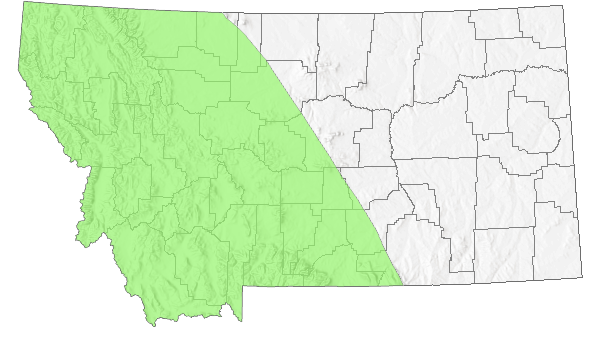
 Summer
Summer
Range Comments
Ranges from British Columbia and Alberta, southward to northern California and Colorado. In Montana, there are confirmed reports for 6 counties (Vickery and Kevan 1985, Pfadt 2002).
Observations in Montana Natural Heritage Program Database
Number of Observations: 11
(Click on the following maps and charts to see full sized version)
Map Help and Descriptions
Relative Density
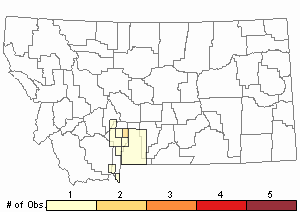
Recency
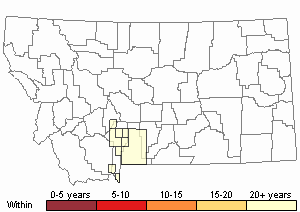
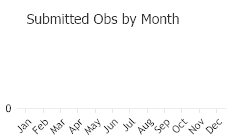

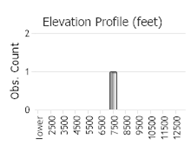 (Observations spanning multiple months or years are excluded from time charts)
(Observations spanning multiple months or years are excluded from time charts)
Habitat
Inhabits foothills, grasslands, and montane parklands ranging from 3200 to 6400 feet (Pfadt 2002).
Food Habits
The Alpine Grasshopper has a diverse diet, and feeds on both forbs and grasses, consisting of "about 26 species of forbs, 11 grasses, and 2 sedges" (Pfadt 2002 for a detailed list of plant food species ingested).
Reproductive Characteristics
Mating generally occurs in mid-August and egg laying about a week later. Females select bare ground between clumps of grass and deposit 8 to 12 eggs per pod (Pfadt 2002).
References
- Literature Cited AboveLegend:
 View Online Publication
View Online Publication Pfadt, R.E. 2002. Field Guide to Common Western Grasshoppers, 3rd edition. Laramie, WY: Wyoming Agricultural Experiment Station, Bulletin 912, modified by S. Schell and S. Schell for electronic publication. Accessed 19 February 2020. http://www.uwyo.edu/entomology/grasshoppers/field-guide/index.html#fieldguidetoc
Pfadt, R.E. 2002. Field Guide to Common Western Grasshoppers, 3rd edition. Laramie, WY: Wyoming Agricultural Experiment Station, Bulletin 912, modified by S. Schell and S. Schell for electronic publication. Accessed 19 February 2020. http://www.uwyo.edu/entomology/grasshoppers/field-guide/index.html#fieldguidetoc Vickery, V. R. and D. K. M. Kevan. 1985. The grasshopper, crickets, and related insects of Canada and adjacent regions. Biosystematics Research Institute, Ottawa, Ontario. Publication Number 1777. 918 pp.
Vickery, V. R. and D. K. M. Kevan. 1985. The grasshopper, crickets, and related insects of Canada and adjacent regions. Biosystematics Research Institute, Ottawa, Ontario. Publication Number 1777. 918 pp.
- Additional ReferencesLegend:
 View Online Publication
View Online Publication
Do you know of a citation we're missing? Anderson, N.L. 1962. Grasshopper-vegetation relationships on Montana grasslands. Ph.D Dissertation. Bozeman, Montana: Montana State University. 73 p.
Anderson, N.L. 1962. Grasshopper-vegetation relationships on Montana grasslands. Ph.D Dissertation. Bozeman, Montana: Montana State University. 73 p. Capinera, J.L., R.D. Scott, and T.J. Walker. 2004. Field Guide to Grasshoppers, Katydids, and Crickets of the United States. Ithaca, NY. Cornell University Press.
Capinera, J.L., R.D. Scott, and T.J. Walker. 2004. Field Guide to Grasshoppers, Katydids, and Crickets of the United States. Ithaca, NY. Cornell University Press. Hebard, M. 1928. The Orthoptera of Montana. Proceedings of the Academy of Natural Sciences of Philadelphia, Vol. 80:211-306.
Hebard, M. 1928. The Orthoptera of Montana. Proceedings of the Academy of Natural Sciences of Philadelphia, Vol. 80:211-306. Helfer, J.R. 1971. How to Know the Grasshoppers, Crickets, Cockroaches, and Their Allies. Revised edition (out of print), Mineola, NY: Dover Publications.
Helfer, J.R. 1971. How to Know the Grasshoppers, Crickets, Cockroaches, and Their Allies. Revised edition (out of print), Mineola, NY: Dover Publications. Henry, J.E. 1969. Protozoan and viral pathogens of grasshoppers. Ph.D. Dissertation. Bozeman, MT: Montana State University. 153 p.
Henry, J.E. 1969. Protozoan and viral pathogens of grasshoppers. Ph.D. Dissertation. Bozeman, MT: Montana State University. 153 p. Scott, R.D. 2010. Montana Grasshoppers, Katydids, and Crickets A Pictorial Field Guide to the Orthoptera. MagpieMTGraphics, Billings, MT.
Scott, R.D. 2010. Montana Grasshoppers, Katydids, and Crickets A Pictorial Field Guide to the Orthoptera. MagpieMTGraphics, Billings, MT. Wachter, D.H. 1995. The ecology of selected grasshopper species along an elevational gradient. M.Sc. Thesis. Bozeman, Montana: Montana State University. 59 p.
Wachter, D.H. 1995. The ecology of selected grasshopper species along an elevational gradient. M.Sc. Thesis. Bozeman, Montana: Montana State University. 59 p.
- Web Search Engines for Articles on "Alpine Grasshopper"
- Additional Sources of Information Related to "Insects"





